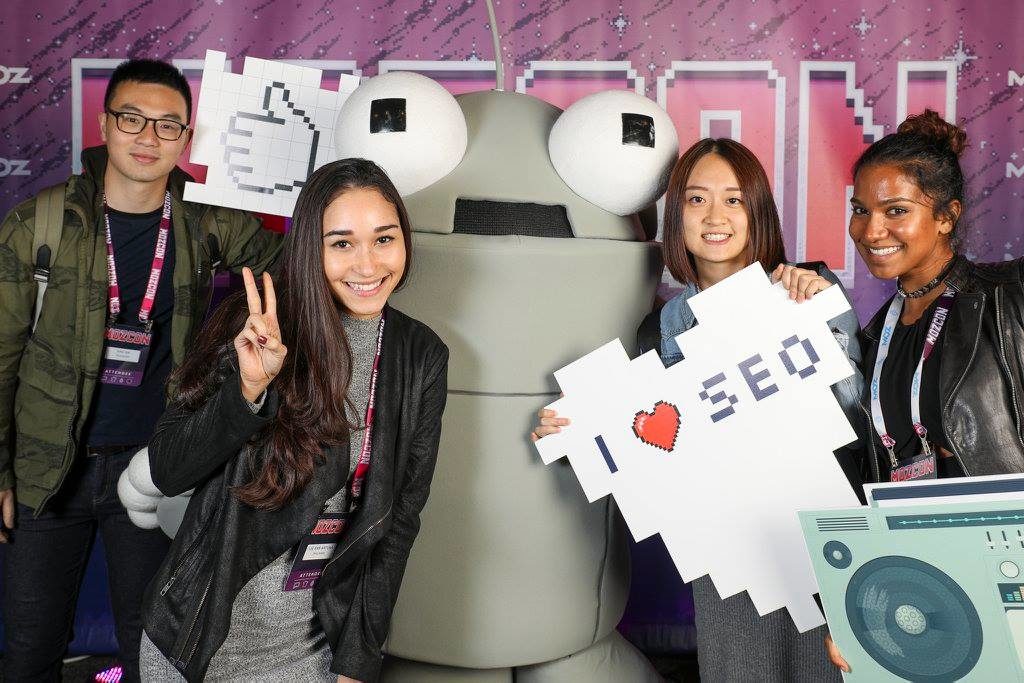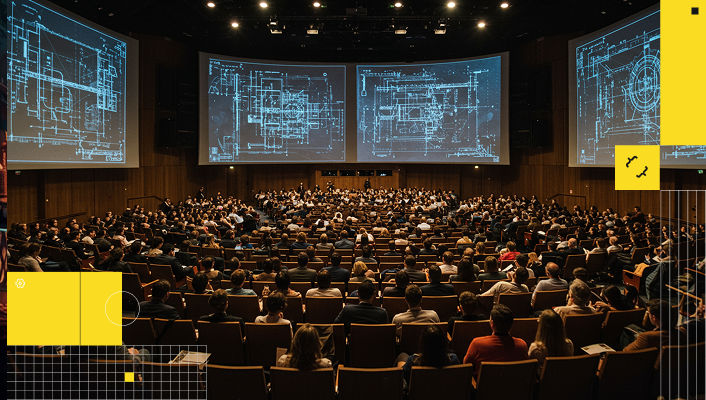It all started with a Slack message from our CEO, Mike King. Seven lucky iPullRankers were going to one of the largest and highly-rated digital marketing conferences in the country, MozCon.
On a beautiful Sunday morning, we left our NYC agency grind behind to get on a flight to Seattle and attend Moz’s “not so typical” marketing conference. For some of us, it was our first time and for some it was a second or third. Our initial expectation was to gain valuable insight into new marketing tips and tools that we could utilize in our daily roles – we received so much more.
MozCon offered each of us a fresh perspective on our areas of expertises. More than simply shift our perspective, MozCon dismantled what we thought we knew about our roles and led us to reassess our entire approach. Join us on our journey into the new normal of digital marketing.
“Don’t call me a Copywriter, call me a Strategic Storyteller”
In my early days as a copywriter, catchy was king. Advertising school taught me how to be clever and engaging, agency life taught me how to call everyone to action. None of these marketing tactics are wrong but they were only half the story. At iPullRank, our market research team spends extensive time on target customer research and analysis – from keywords to every stage of the purchase funnel, we uncover it all. Using this data, I craft my copy like a weapon of choice in the mission to conquer my ultimate goal – the target customer. While weapons and targeting may score you a sale, they won’t win the heart of a lifelong customer. Clever and engaging copy is awesome but only if it’s part of a larger narrative about the customer.

Crafting copy with one person in mind
MozCon taught me that your brand messaging is more than just a slogan or a catchphrase. It’s a story with a beginning, middle and end where the customer is always the hero. Your brand or product messaging shouldn’t be a vague, hook line & sinker but a strategic story that conveys real emotion and offers a directive. As a copywriter, my job is to convey a story that my customer can see themselves starring in. Why else would they care? Instead of trying to be “everything to everybody” as Wistia’s Kristen Craft so cleverly put it, the goal is to write with one person and one moment in mind. This is the difference between personalized and mass marketing. This year’s MozCon did away with the typical rules of copywriting. Instead of focusing on how many words a headline should be or what color to make the CTA button, they perfectly explained how the new normal of digital marketing isn’t just a race to the top of the SERP. Instead, it’s identifying and executing the most efficient way to get the right products and services in front of the customers who need them. Period.
“Don’t call me a UX/UI Designer, call me a Curator of Experiences”
Developing a culture of A/B testing
UX/UI Designers are experts in creating and implementing user-first experiences. MozCon helped evolve my current role as a UX/UI Designer by instilling the fact that creatives should seek to refine their processes by including scaleable project plans and increased collaboration with the overall goal of developing a culture of A/B testing. During her “Uplevel Your A/B Testing Skills”, Cara Harshman gave insight on the problems that we face when we implement decisions solely based on ideas from internal and subjective discussions; instead of striving to enhance our projects by answering questions and solving problems for the user.
When executing A/B testing, it is easy to jump into your own subjection and implement solutions that are gut-based or ego-driven. It is crucial to start creative projects with a hypotheses and scalable goals, in order to be able to test more effectively based on your data and while measuring success.
How to turn execution into automation?
“If you want to scale your work, you need to take off your get-shit-done hat” -Cara Harshman
Agencies tend to uphold a “just get shit done” mantra in order to ensure that we deliver our clients’ work on time. But sometimes, it is necessary to take the time to improve overall quality by refining processes and allowing testing to be a priority.Cara emphasized enforcing scalable project plans by including a hypothesis, measureable goals and a quality assurance process. We can do this by thinking large scale and by standardizing success metrics for goals. As the role of an UX/UI Designer is to maximize user experience, and while creating experiences, it is necessary to gauge the level of satisfaction of the user as well.
MozCon inspired me to establish a concrete hypothesis and data-driven goals for future analysis of A/B test results. By answering question like A) does it match our hypotheses? and B) do we solve the problem? With these components incorporated into our strategy, we can improve the overall user experience, create better case studies and grow as better designers through relearning and evaluation.
“Don’t call me an SEO, call me an Usability Analyst”
SEO’s have the luxury or curse (depending on who you talk to) of having a title that the general public considers to be a noun, when it’s really a verb. I have always thought of SEO as the marketing philosophy that merges search-ability and monetization with user experience. When done correctly, SEO is part of a company’s total marketing plan. To that end, Mozcon 2016 helped to reinvigorate my commitment to focusing on the user experience as part of that philosophy.

Before Mozcon, I knew that rich snippets or as many know them, the Google search results answer box, could provide a benefit to SEO’s leveraging content strategies. Data in the past years had shown increased click through rates for clients whose pages appeared as part of the answer box. I was not aware, however, that in the first half of 2016 rich snippets’ visibility were up to 15% more than the previous year. Seeing the “paragraph answer” as the most common response to “do” questions made sense, but I didn’t foresee how the rich snippet would evolve. Because Google matches the format of the rich snippet to the format on the site, as a marketer you have to understand how the users will benefit from the content in both locations.
Rich snippets are evolving
During his “Taking the Top Spot: How to Earn More Rich Snippets”, Rob Bucci from STAT Search Analytics highlighted how Google is developing a better understanding of the formats today’s SEOs are using to present content to them. He also brought up the curious case of image snippets declining due to the increase in voice search from not only mobile, but desktop searchers. I am going to tweak some of our local SEO strategies, based on the understanding that rich snippets never trigger for local queries. I can’t wait to test out which keyword variations are leading to increased snippets. Not only does understanding how Google displays weak snippets contribute to our competitive analysis, but understanding the user experience will help keep our SEO philosophy ever advancing.
“Don’t call me a Developer…call me maybe”
– Bing Bai

Let me explain…
It would be ideal if we had an overarching solution for the problems we encounter in digital marketing. Almost like an all-encompassing formula that provides solution Y when X action is performed. However, what I learned from Mozcon is that most of the time, there is no “golden rule” in the digital marketing arena. Digital marketing solutions should always be viewed as an hypothesis to be tested. Here’s why a culture of testing and experimentation is so crucial to digital marketing.
Data alone is unpredictable. So are people.
Cara Harshman explains that a hypotheses that ties directly to your campaign objectives is the first step in A/B testing. Another Moz Speaker, Ross Simmonds of Crate, demonstrated why testing is also crucial to content and introduced his very own content experiment formula, “BUILD – SHIP –LEARN – DECIDE”. When taking a closer look at his presentation, you will find that the “BUILD” step is actually creating a hypotheses, while “SHIP – LEARN” can be interpreted as testing. The results from testing contribute to the “DECIDE” component of Ross’ content experiment formula. By testing, we can better understand user behavior and continue to refine our hypotheses.
So is Google.
This is why Mike Arnesen’s presentation on using Google Tag Manager was so valuable. For example, using GTM to update metadata. Google claims that their crawler has no problem with JavaScript anymore, but GTM is actually loaded asynchronously. This means that metadata is updated via GTM at an unknown time. According to Mike’s experiment, this will work but as mentioned before, test it to make sure.
Dr. Pete Meyers’ presentation, “You Can’t Type a Concept: Why Keywords Still Matter”, further solidifies the need to test and innovative, even as a developer. His “GATHER – GROUP – GENERATE” approach for keywords opens the door for keywords optimization to the machine learning search engine world. He tried his best to build a tool to imitate how Google’s “brain” might think. This is crucial for the “GROUP” component in his approach. However, Google still won’t tell him if his tool works like Google. Again, this is where testing comes in.

Here’s my hypothesis, so test it, maybe?
Don’t assume that things will work perfectly right away. Testing not only optimizes your results, but teaches you key lessons for future campaigns. If you don’t have enough time to test every campaign at it’s infancy, at least test it when you make a major change or add something new.
“Don’t call me a Link Builder, call me a Relationship Acquisitor”
Link builders are often thought of as the marketers that build relationships between sites and pages, but, more importantly, link builders are actively building relationships with people in relevant communities. MozCon left me with specific takeaways to improve and refine our processes in strategic link building, relationship building and PR.
Changes in link evaluation
Rand’s discussion on link acquisition gave key insights on both link evaluation and architecting a link building strategy. Link evaluation algorithms are (per usual) evolving as Google transforms itself into a “machine learning first” company. Algorithms are still favoring links that are satisfying searcher’s needs and wants. Many factors remain relevant from domain authority to anchor text to location on page. One particular item that stood out to me was the fact that Google may now consider domain reputation in correlation with author authority while evaluating links. For example, if a credible author from The New York Times links to a site it may pass more value than an anonymous author or a less credible contributor. This could potentially alter how we prospect and how we perform outreach. In addition, Google will increasingly consider aggregate behavioral data, including “short-click” and “long-click” results as well as bounce rate when determining link’s value and SERP results.
As a result, digital marketers should continue to produce meaningful and resourceful content for our audience(s). Rand’s presentation establishes the fact that link builders and promotion leads should work in strong collaboration with content strategy teams to brainstorm, analyze and produce content.
Strategic link building and content strategy
It is more important than ever for link builders to contribute and have an impact on strategic components within a marketing strategy, particularly content strategy. Rand laid out 5 unique long term link building strategies that further solidifies it is crucial to build relationships and utilize partnerships for link acquisition. Long term strategies are most beneficial when including link goals, a strategic approach, tactical initiatives and KPI metrics. Determining KPI metrics within your link building strategy allows for a more effective process and learning initiative for future projects.
MozCon reinstated my commitment to connecting people to content they will find resourceful and valuable, and that starts with content strategy. The Content Marketing Path, a long term link building strategy that Rand mentions, is a solid foundation for streamlining the process between content strategy and strategic link building. Among the many insights I received from Rand’s discussion, his focus on orthogonal alignments were particularly impactful. This includes content surrounded around social causes, sponsorships and employee programs – which are all great content angles that can increase brand awareness and link value.
“Don’t call me a Data Scientist, call me a Personalization Artist”
Although the Data Scientist has been declared the sexiest job of the 21st century by Harvard Business Review, others still stereotype data scientists as nerds that are disconnected from the real world. Data scientists in marketing are often found asking “unworldly” questions such as, “is this decision data-driven”, “how much convention rate can be increased after this change”, or “has this test reached statistical significance”. The answers to these questions are important. More importantly, all the analysis should be empathy based and great A/B tests hypotheses are born out of reason and data.

Before MozCon, I pictured conversion rate optimization as a three step process: hypothesize, optimize and verify. However, one of the biggest optimization challenges was underemphasized: knowing what to test. Instead of only focusing on testing, conversion rate optimization should be a five step process starting with identify and prioritize. At the identification stage, the major task is to translate insights from analytics and voice of the customers into testable hypotheses. To prioritize what to test, we need to set up an emotion-free system where every hypothesis gets a score.
Bringing out the best in personalization
Here are a few things we can do to achieve next level personalization. Firstly, sitting with customer success teams or recording user testing sessions are good ways to help us identify what to test based on the voice of customers. To prioritize hypothesis, we can create a scorecard and rank hypothesis based on score, which includes factors like conversion lift potential, ease of development, how important the page is to your overall strategy, how much audience will be affected, etc. In the end, we need to incorporate developers and designers to make changes on the website from the perspectives of clarity, readability, and visual identification. Cara Harshman debunked the myth that conversion rate optimization is totally data driven, and is, in fact, it is the combination of science and art which brings out the best in personalization.
“Don’t call me an Account Manager, call me a Reputation Marketer”
Walking into Mozcon I wasn’t entirely familiar with reputation marketing, but assumed it had strong ties to public relations or managing a brand’s community. While those things may all be in the same realm, there are certain nuisances that separate them and each requires a pretty different approach for any business. Thankfully, Rhea Drysdale of Outspoken Media was there to set me straight.

When you hear the words ‘reputation management’ you automatically think the perception of the public eye. Isn’t this much like brand management? Rhea’s talk taught me that brands create impressions that evoke an emotion, whereas reputations make an individual act based on experience. When I think about it from the perspective of an account manager here at iPullRank, the entirety of my job is to ensure that my client base has a positive experience with our agency. In essence I am a reputation marketer as well as a client experience manager for iPullRank. Reputations are built through consistency, dedication and positive experiences. These are all key attributes of any impactful, results driven, agency. Every customer experience counts.
Developing metrics to evaluate reputation
In theory this sounds great, but how do you actually measure and track reputation? It’s incredibly important for any organization to develop a reputation score by combining relevant KPI’s such as net promoter score, CEO approval rating, customer reviews, news mentions, exit interviews, etc. and tracking/communicating them in an effective way. It’s up to the organization to determine metrics contribute to reputation and what impact they actually have.
I walked away from Rhea’s talk with a newfound appreciation for reputation marketing and its importance in any organization. She ended her talk by mentioning that up to 60% of a company’s market value can be determined by corporate reputation. This means that a consistent focus on improving your company’s reputation through fostering positive relationships and experiences is adding value to your company and improving your bottom line.
Marketing to Humans > Marketing to Users
All in all, MozCon emphasized re-introducing the human element back into digital marketing. Identifying strategies and creating experiences that make the customer the “hero” was, is and always will be the essence of digital marketing. Many of our takeaways were different, but they are similar in the root of being user focused and driven.
We learned that we can evolve by continuously optimizing our current roles with fresh tactics and approaches, producing content that solves problems but always keeping the most vital factor at the forefront – the customer.
Additionally, MozCon credited the thought that, as marketers, we should seek to dive into skillsets we aren’t so familiar with in order to have a more well rounded perspective on the overall user experience. Thank you Rand, to the Moz staff and to the speakers at MozCon for your thought leadership. Our experience at MozCon was anything but “typical”.
- A Content Exercise: Using Link Building Prospecting for Content Brainstorming - March 9, 2017
- Why Your Link Building Gets Rejected & How to Fix It - November 30, 2016
- Don’t Call Us Marketers: How MozCon Defined the New Normal of Digital Marketing - September 23, 2016







